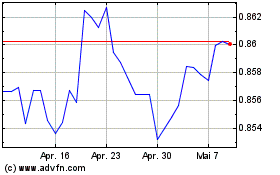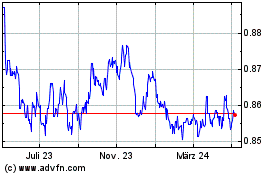Euro Drops On German Political Uncertainty
02 Juli 2018 - 8:26AM
RTTF2
The euro drifted lower against its major counterparts in early
European deals on Monday, as political crisis in Germany mounted
after German interior minister Horst Seehofer had offered to resign
amid confrontation with Angela Merkel over refugee policy.
Rejecting the EU migration deal negotiated by Merkel, Seehofer
offered to step down from his ministerial role and party leadership
on Sunday, threatening the coalition government to the brink of
collapse.
Seehofer complained in Munich that he had engaged in a
"conversation with no effect" with Merkel, when they held talks
about the EU deal on migration.
Final data from IHS Markit showed that Eurozone factory activity
grew at the weakest pace in more than a year in June.
The factory Purchasing Managers' Index fell to an 18-month low
of 54.9 in June from 55.5 in May. This was slightly below the flash
estimate of 55.0.
In Germany, the headline IHS Markit/BME PMI fell to an 18-month
low of 55.9 in June, in line with flash estimate, from 56.9 in May.
The index has declined in each of the past six months from a
survey-record high last December.
The currency has been trading in a negative territory against
its major rivals in the Asian session.
The euro dropped to 1.1626 against the greenback, from a
session's high of 1.1690 seen at 5:00 pm ET. If the euro continues
its fall, 1.15 is possibly seen as its next support level.
Pulling away from an early near a 3-week high of 129.50 against
the yen, the euro edged down to 128.63. Next key support for the
euro is likely seen around the 126.00 level.
The latest survey from Nikkei showed that Japan manufacturing
sector continued to expand in June, and at an accelerated rate,
with a manufacturing PMI score of 53.0.
That's up from 52.8 in May, and it moves further above the
boom-or-bust line of 50 that separates expansion from
contraction.
The single currency fell to 1.5316 against the loonie and 1.1535
against the franc, off its early highs of 1.5359 and 1.1569,
respectively. The euro is seen challenging support around 1.51
against the loonie and 1.14 against the franc.
On the flip side, the euro bounced off to 0.8850 against the
pound, from a 4-day low of 0.8832 hit at 5:15 pm ET. On the upside,
0.90 is possibly seen as the next resistance level for the
euro.
Survey results from IHS Markit showed that the UK manufacturing
sector growth remained subdued in June.
The IHS Markit/ Chartered Institute of Procurement & Supply
factory Purchasing Managers' Index rose slightly to 54.4 in June
from revised 54.3 in May. The score was almost four points below
the 51-month high reached in November 2017.
The 19-nation currency recovered to 1.7251 against the kiwi and
1.5806 against the aussie, from its early lows of 1.7181 and
1.5750,respectively. The euro is seen finding resistance around
1.74 against the kiwi and 1.59 against the aussie.
Looking ahead, U.S. construction spending for May and ISM
manufacturing index for June will be out in the New York
session.
Euro vs Sterling (FX:EURGBP)
Forex Chart
Von Mär 2024 bis Apr 2024

Euro vs Sterling (FX:EURGBP)
Forex Chart
Von Apr 2023 bis Apr 2024
